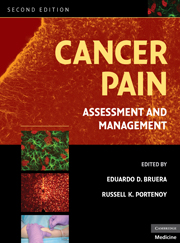Book contents
- Frontmatter
- Contents
- Contributors
- Preface
- SECTION I MECHANISMS AND EPIDEMIOLOGY
- SECTION II EPIDEMIOLOGY AND SYNDROMES
- SECTION III ASSESSMENT
- SECTION IV PHARMACOLOGICAL TREATMENT
- SECTION V OTHER INTERVENTIONAL STRATEGIES
- SECTION VI REHABILITATION AND PSYCHOLOGICAL INTERVENTIONS
- SECTION VII THE ROLE OF ANTINEOPLASTIC THERAPIES IN PAIN CONTROL
- SECTION VIII PAIN IN SPECIAL POPULATIONS
- SECTION IX DIFFICULT PAIN PROBLEMS
- SECTION X SYSTEMS OF CARE
- 29 Integrating cancer pain management into hospice practice and institution-based palliative care programs
- 30 Pain in medical illness: ethical and legal foundations
- 31 Understanding clinical trials in pain research
- 32 Legal and regulatory aspects of opioid treatment: the United States experience
- 33 Role of family caregivers in cancer pain management
- 34 Cancer pain and palliative care in the developing world
- Index
- Plate section
- References
29 - Integrating cancer pain management into hospice practice and institution-based palliative care programs
from SECTION X - SYSTEMS OF CARE
Published online by Cambridge University Press: 06 July 2010
- Frontmatter
- Contents
- Contributors
- Preface
- SECTION I MECHANISMS AND EPIDEMIOLOGY
- SECTION II EPIDEMIOLOGY AND SYNDROMES
- SECTION III ASSESSMENT
- SECTION IV PHARMACOLOGICAL TREATMENT
- SECTION V OTHER INTERVENTIONAL STRATEGIES
- SECTION VI REHABILITATION AND PSYCHOLOGICAL INTERVENTIONS
- SECTION VII THE ROLE OF ANTINEOPLASTIC THERAPIES IN PAIN CONTROL
- SECTION VIII PAIN IN SPECIAL POPULATIONS
- SECTION IX DIFFICULT PAIN PROBLEMS
- SECTION X SYSTEMS OF CARE
- 29 Integrating cancer pain management into hospice practice and institution-based palliative care programs
- 30 Pain in medical illness: ethical and legal foundations
- 31 Understanding clinical trials in pain research
- 32 Legal and regulatory aspects of opioid treatment: the United States experience
- 33 Role of family caregivers in cancer pain management
- 34 Cancer pain and palliative care in the developing world
- Index
- Plate section
- References
Summary
Introduction
Institution-based palliative care continues to change rapidly thanks to the commitment of research in the field of palliative medicine. Home hospice care in the United States, however, still struggles to incorporate evidence-based medicine into its medical practice. Multiple reasons exist, including lack of physician leadership due to busy private practices, minimal available full-time opportunities for physicians in hospice care, poor support from hospices in the training and retention of qualified physicians, and a lack of teaching of hospice nursing staff by their team physicians.
We have observed that two main factors affect the care of patients in home hospice today: tradition and economics. Many hospice treatments and guidelines exist because no one has had the time or interest in updating them or because some treatments exceed the allotted budget. With the support of the American Academy of Hospice and Palliative Medicine, however, there is a revival of interest in changing the involvement that physicians have in the care of the dying. Physicians dedicated to the field of hospice care are becoming board certified in hospice and palliative medicine, updating their knowledge, participating in research, developing into excellent teachers, and becoming physician champions for the field.
This is the catalyst that will help the modern hospice movement incorporate evidence-based medicine and best clinical practice into this vital and final phase of the continuum of palliative care.
- Type
- Chapter
- Information
- Cancer PainAssessment and Management, pp. 535 - 552Publisher: Cambridge University PressPrint publication year: 2009



